The History of Woodward Boat Shop
Introduction
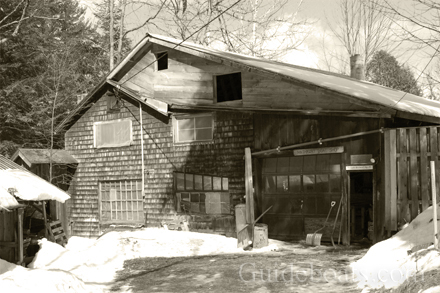
Owned and operated by Christopher Woodward, the shop is the only surviving Guideboat shop of its kind still operating in the Adirondacks. The shop was built in 1930 by famed Guideboat builder Willard Hanmer. After Hanmer died in 1963, Carl Hathaway, who had worked for him, purchased the shop. Hathaway operated the shop through 1990, until Woodward, his apprentice at the time, bought it, and has continued to operate it to date.
Theodore Hanmer
Theodore Hanmer was born on Feb. 26 1860, the son of Truman and Sylvia (Barnard) Hanmer of Black Brook, NY. After attending school in Black Brook Theodore worked driving a stage between Ausable Forks, Paul Smith’s and Martin’s hotels and had acquired a liking for that area. In 1889 he married Emma Abare in Black Brook. As the forges in that section were slowing down and he didn't “get to do all the fishing that he would have liked”, he moved to the Saranac Lakes area in 1890 and hired on to provide fish for Paul Smith’s Hotel. When this deal fell through, he tried his hand at building a boat patterned after those he had seen. “I made a lot of mistakes on that first boat” he confessed, “but I knew what every one was and how to correct it the next time.”
Theodore Hanmer
“Four boatshops were working full time when he came in the 1890s; Will Martin, Fred Rice, Herb Salisbury, and Chet Peck had orders to fill year round for the country was filling up and transportation was needed.” Theodore went to work for Will Martin at his shop located acoss from the Martin Hotel at the intersection of Edgewood Road and Lake Street. This shop was dismantled in 1935. After a few months working for Martin, Theo left to build his own shop at 77 Lake Street. He worked for himself for the rest of his life, except for a brief association with Silas Blauvelt, a local contractor who did some boat work. Other builders in the area were Ricketson in Bloomingdale, and Albert Billings in Lake Placid. “But the best of them was Fred Rice” Hanmer avowed. “I have seen Rice boats that were 40 years old, without a split or warp along the seams.” Hanmer acquired Rice’s boat patterns in 1903 when Rice moved to Seattle, Washington.
Theodore Hanmer
Theodore and Emma had 10 children, two of whom died in infancy. The surviving eight were two boys and six girls. The boys, Truman and Willard both worked with their father building boats. Willard worked with Theodore for 18 years until he built his own shop at 202 Lake Street. Theodore continued to build boats into his eighties living at 123 Lake Street with his son Truman. He died in Saranac Lake on April 20, 1957 at the age of 97, one of Saranac Lake’s oldest and most respected residents. With his sons, he had built over 200 guideboats, flat skiffs, launches, outboards and canoes as well as oars paddles and the accessories for them.
Willard Hanmer
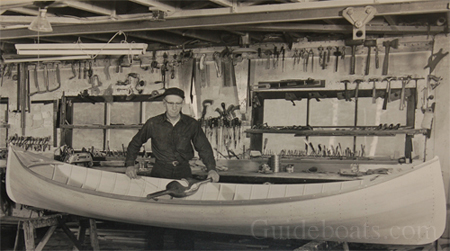
“It takes a woodsman to build a woodsman’s boat and Will’s still the best boatbuilder in these parts.” Thus spoke Theodore Hanmer about his son Willard. And having taught him both the boat builders craft and the woodsmen’s arts that was high praise indeed.
Willard was born in 1902 the eighth child and second son of Theodore and Emma Hanmer. As a child he started to help his dad when he was nine or ten years old. “I used to go and stick tacks for him. If you got in trouble in school, when you got home you would have more tacks to stick. Then I learned to cane boat seats. I had my share of that. My wife does all that for me now and it certainly helps.”
“I learned to cane boat seats. And as I got older he would teach me how to do a lot of work; well, mostly sand-papering. All there was to that; it was all done by hand. You couldn’t hurt anything, and it would take a long time to rub a hole through a boat by hand. Still would, I guess.”
Willard Hanmer
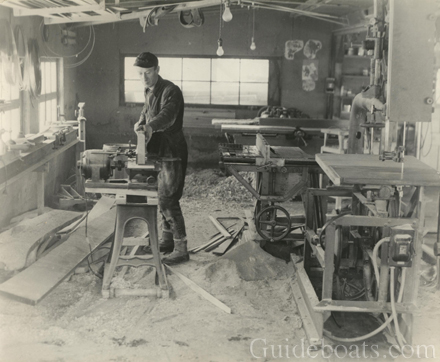
Willard worked for his father for about 18 years until 1928 when he married Pauline ‘Ben’ Bennett, a school teacher from Dexter Maine. Using machinery acquired from the Martin boat shop, and the patterns from his father, he and his wife went to work for themselves. They built the shop at 202 Lake Street in 1930, where Willard and his wife built guideboats for 33 years. He slowly bought more machines and tools as he went along, including a Lane sawmill. He mostly built boats in the winter and spring, going out on the lakes to do repairs on all types of boats during the summers and hunting in the fall.
Willard Hanmer
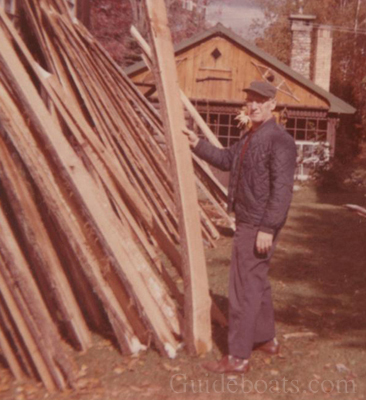
Willard used the same patterns as his father, making subtle changes as he went along but not changing the patterns themselves. His greatest innovation was in the mechanization of the process of getting out the ribs and planking. With the advances in technology of power tools such as table saws, shapers, and sanders, he was able to greatly reduce the time it took to “get out” or break down the raw materials - root slabs and rough lumber - into the component parts of a boat. He developed patterns for use on the shaper to guide the cutting out of his ribs and planking, thereby ‘mass producing’ pieces for his boats. Another time saver was the use of a disc sander to lay on the planking bevels. However the majority of the construction process was still done by hand.
Willard Hanmer
Willard Hanmer built several different styles of boats. He had three basic sizes of guideboats; 16’, 14’, and a 12’ model. He also built a canoe in the guideboat style with sawn crooks for ribs and beveled lap planking. He also built several transomed row/motor boats in this same process. Over the course of his 30 some years as a builder he changed the deck designs 3-4 times, ending with a hand hold cut out in the deck. His wife Ben worked with him. sanding, tacking, finishing the boats, and doing the seat caneing. After his death in 1963 she finished up his remaining boats.
Carl Hathaway
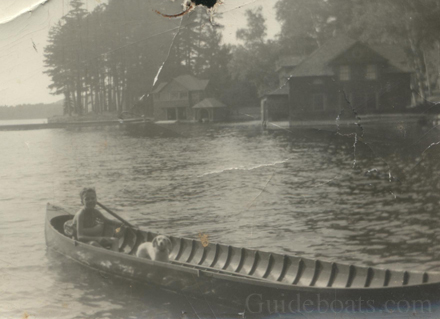
Carl Hathaway did not set out to become a boat builder, it came about by necessity. In fact, when asked, he refers to himself as a boat restorer more so than a builder.
Carl was born in Tupper Lake on December 30th, 1929, the only child of Albert John Hathaway and Ester Cutting Hathaway. He lived in the house he was born in on Lakeview Street until he was 5 years old. At that time they moved to Upper Saranac Lake where his father became the caretaker for Colonel Wetherill at the Bucknell Camp. Growing up on the lake, doing chores for his father, he was exposed to the boats and the maintenance required to keep them in shape.
Carl Hathaway
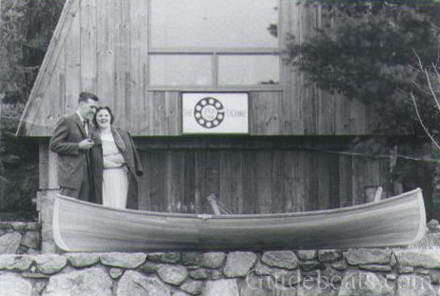
It was during these years that Carl first met Willard Hanmer when Hanmer cut Hemlock cants for the elder Hathaway to use as dock cribbing. Young Carl then helped Willard on the mill as the tail man from time to time. During his youth Carl attended school at Corey’s for a time, then in Tupper Lake. As Tupper Lake was 15 miles away by foot, Carl boarded with families in town, returning to camp on the weekends. After high school Carl went to work for his father at the camp, cutting ice and firewood in the winter months for the surrounding camps and doing some guiding during hunting season. Carl met and married Valda Ryan from Chateaugay on September 22nd, 1950 when he was twenty years old. They took up residence at camp, renting out a small apartment.
Carl Hathaway
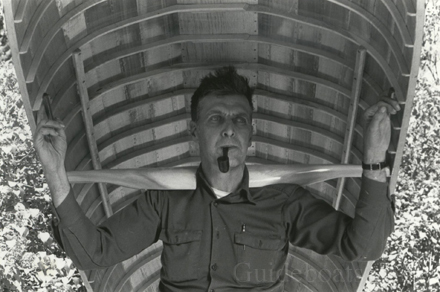
On the 25th of November, 1950 a severe southeasterly storm blew all day with winds reaching in excess of 55 miles per hour. The resulting blowdown devastated forest stocks amounting to 1.25 million board feet of hardwood and 2 billion board feet of softwood, the impact of which is still felt today. When the state bid out contracts for the salvage of the timber, Carl went to work harvesting the logs with horses, working in the woods for the next two years.
During this time, Judy, the first of his two daughters, was born. With a growing family to feed and clothe, Carl felt the need for more stable employment. When an adjacent camp approached him about taking over as caretaker for them, he agreed, moving his family about one mile from his childhood home across the bay to work for the Loeb family at Gull Bay camp. In 1955 he started as caretaker where he worked for the next 43 years, retiring in 1998.
Carl Hathaway
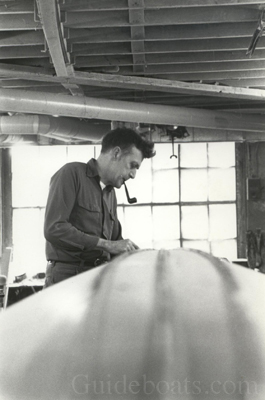
While life as a caretaker has its pluses - such as year-round employment and salary and housing - it also has its downsides such as the lack of home-ownership or retirement or pension plans. Many a caretaker has been hurt, disabled or grown to old for the demands of the job, or just due to the vagaries fancies or whims of the owners and found themselves out on the street with nothing more than a hand shake and a pat on the back. Carl, who had done some work on the sawmill with Willard Hanmer, was asked if he would be interested in helping out during the winters at the boat shop. So for the winters of 1960-61 Carl went to work for Willard. Or more precisely, for Ben. His duties were to sand the boats smooth in preparation for finishing which under her guidance was no easy task. During the second winter there, Willard started to show Carl some of the secrets of building that he had perfected over the years. However, unfortunately before Carl could complete his apprenticeship, Willard died. Carl helped Ben finish up the remaining boat finishing and went along his merry way. In 1963, Ben offered to sell the shop to Carl, holding the mortgage in order to make it financially possible. Carl, needing something to fall back on if things got tight at camp, took the offer and bought the shop. This gave him relief of pressure from being beholden to the camp owners without a skill or means of support should he want to leave.
Carl Hathaway

The majority of work at the shop was repair work. For the first several years Carl worked evenings and in the winters, repairing and restoring guideboats, wood canvas canoes, sail boats skiffs, and inboard Mahogany runabouts from the surrounding lakes and camps. In 1967 Carl Built his first boat as a spec boat because every time he was asked if he had built a boat he had to answer no, even though he had made and replaced every piece on a guideboat. However with that answer “he might as well sit down, pour himself a cup of coffee, light his pipe, and put his feet up because they would then proceed to tell him all about how to build a boat.” So that fall he told Val that he was going to build a boat. “Was it sold?” she queried. “No” was the reply, “but I have to in order to shut these so called ‘experts’ up and get some work done.”
Carl Hathaway
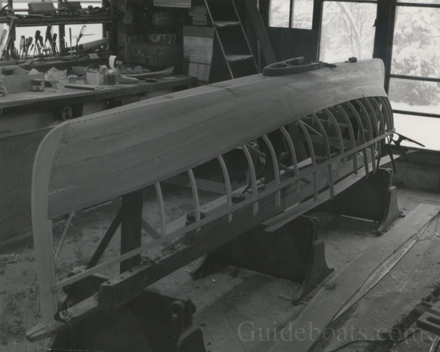
Carl built his first boat using the shop patterns, and remembering what he had seen Willard do. Like all true woodsmen, using a dose of common sense, he was able to puzzle through his first boat, making a very acceptable first attempt. As he had already made and replaced every part on a guideboat in one form or another this was not that far removed from building one from the ground up. By remembering each misstep and correcting them he soon was building new boats with the confidence and ability of a master builder. However new boats are few in numbers, and with demand for repairs high, the majority of output from the shop was repair work. There is more money in repairs, the outlay of materials is less and the work is steadier. Demand for new boats waxes and wanes with the economic times while the repairs and restorations stays on a more even keel.
Carl Hathaway
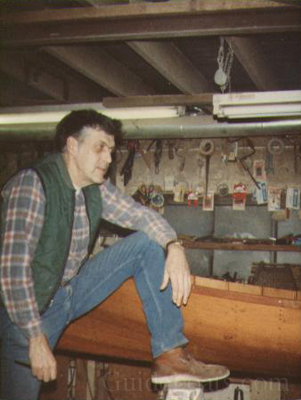
By 1980 Carl had built a dozen or more new boats and had repaired and restored hundreds more. As more work came in and fewer shops survived Carl employed several local men at one time and another. Names like Dick Bomyea, Clint Beaney, Mory Brigham, Ed Marshall, and Ralph Morrow were well known as reliable craftsmen and boat repairers. Of them Ralph Morrow stands out as a builder in his own right.
NCCC
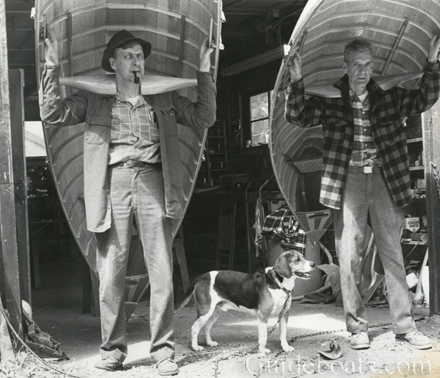
In 1980, Ralph and Carl were the only two guideboat builders still working. Robert Klein and Murray Hellar at North Country Community College in Saranac Lake, seeing a need for saving this important Americana history, secured funding for an Adirondack Guideboat apprenticeship program as part of the Adirondack Studies curriculum and contracted Carl and Ralph to teach Guideboat building. The course ran from fall to spring, 6 hrs a week for 20 weeks two nights a week, with 10 students participating. The class built a boat from start to finish, beginning with digging stumps for root stock, and ending with a complete Adirondack Guideboat
Christopher Woodward
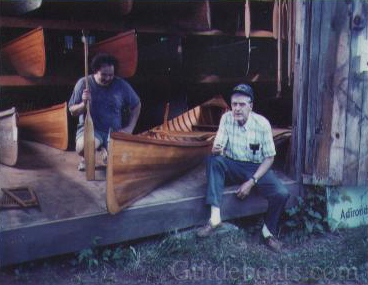
My father was a retired Navy officer and we always had wooden skiffs when we were growing up (not Guideboats) that we had to repair and maintain. He did a lot of woodworking and puttering in his shop, including building a wooden garvey. So I got exposed to tools, sanding, and rowing, at an early age. In my teens, I had a wood and canvas canoe that my friends and I paddled about quite a bit. A friend of mine had access to an Adirondack Guideboat, and I was quite taken with it. I much preferred rowing to paddling. After seeing the collections at the Adirondack Museum, I became determined to build one, and set out to figure out how to do so.
I was among the 10 students in the first class held at Carl’s shop from the fall of 1980- spring of 1981. At the end of the course we had a boat that we then christened and rowed. An advanced course was offered to those who took the first level which I also participated in. This course started out with taking patterns from an old boat and then building it. These courses gave me the needed information and skills to build a boat as well as introducing me to Carl Hathaway.
Christopher Woodward
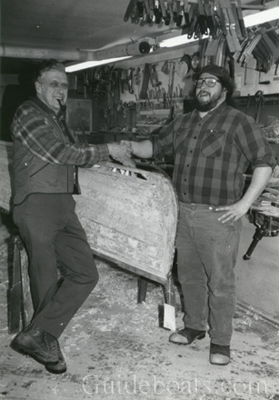
Over the next few years we kept in contact, until he needed someone to work in the shop. During the winters I would help him in cutting ice and filling the ice house for the camp where he was caretaker. At this time I was employed in various jobs including working in the Young Adult Conservation Corps, for the 1980 Winter Olympics, as a caretaker, laborer for local construction firms, field hand, and for two other boat builders building classic wooden runabouts and vacuum bagged composite boats. In 1987 I started working for Carl in the shop, restoring boats, until finally buying the shop in 1991. In this time period, Carl let me set up and build my first boat at his shop. Since then I have built 14 new boats and have restored and repaired hundreds more. And I’ve been going at it ever since; working hard or hardly working.
